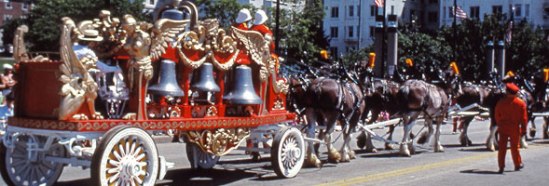. 1660 ~ Johann Sigismund Kusser (or Cousser), composer of Hungarian parentage active in Germany, France, and Ireland
. 1778 ~ Fernando Sor, Guitar composer
More information about Sor
. 1867 ~ Johann Strauss’ magnificent Blue Danube Waltz was played for the first time at a public concert in Vienna, Austria.
. 1870 ~ Leopold Godowsky, Polish American pianist, composer, and teacher
. 1873 ~ Feodor Chaliapin, Russian Bass
. 1883 ~ (Wilhelm) Richard Wagner passed away
More information about Wagner
. 1895 ~ France, There’s no business like show business, right? Well, this is where it all started. A patent for a machine “to film and view phronopotographic proofs” (in simpler words, a projector) was assigned to the Lumiere brothers of Paris.
. 1904 ~ Wingy (Joseph Matthews) Manone, Trumpeter, singer, bandleader
. 1914 ~ The American Society of Composers, Authors and Publishers (known as ASCAP) was formed in New York City. The society was founded to protect the copyrighted musical compositions of its members.
. 1918 ~ Oliver Smith, Scenic designer for Broadway Musicals such as On the Town, Brigadoon, My Fair Lady, Camelot, The Sound of Music, Hello Dolly! and films Guys and Dolls, Oklahoma!, Porgy and Bess, The Band Wagon
. 1919 ~ “Tennessee” Ernie Ford, American country music singer and songwriter
. 1920 ~ Eileen Farrell, American soprano, San Francisco Opera, Lyric Opera of Chicago, Metropolitan Opera. Also successful in singing and recording popular music and jazz
. 1940 ~ Earl ‘Fatha’ Hines and his orchestra recorded the classic Boogie Woogie on St. Louis Blues on the famous Bluebird record label.
. 1925 ~ Gene Ames, Singer with The Ames Brothers
. 1929 ~ Jesse McReynolds, Guitarist, folk singer with Jim & Jesse
. 1930 ~ Dotty McGuire, Singer with McGuire Sisters
. 1940 ~ “Boogie Woogie on St. Louis Blues” was recorded by Earl “Fatha” Hines and his orchestra. The song eventually became a classic and is still popular among big band fans today.
. 1944 ~ Peter Tork (Peter Halsten Thorkelson), Bassist, singer with The Monkees
. 1950 ~ Roger Christian, Singer with The Christians
. 1956 ~ Peter Hook. Bass with Joy Division
. 1957 ~ Tony Butler, Bass with Big Country
. 1967 ~ The Beatles released the double A-sided single in the United Kingdom with Penny Lane (Paul McCartney) and “Strawberry Fields Forever” (John Lennon) on the other side. Penny Lane was where Lennon and McCartney would meet to go into Liverpool.
Strawberry Fields was named after a Salvation Army house where Lennon would play as a child.
. 1971 ~ The Osmonds, a family singing group from Ogden, Utah, began a five-week stay at the top of the pop music charts with the hit, “One Bad Apple”. The song, featuring the voice of little Donny Osmond, also showcased the talent of Alan, Wayne, Merrill and Jay Osmond. The brothers were regulars on Andy Williams’ TV show from 1962 to 1967. The group began as a religious and barbershop quartet in 1959. Together, the Osmonds scored with 10 singles in four years — four of them were top ten hits.
. 1976 ~ Lily (Alice) Pons passed away
. 1990 ~ Musical highlight of glasnost when cellist/conductor Mstislav Rostropovich returned to Russia after a 16-year absence. Russian listeners cheered wildly when he played American favorite march, “Stars and Stripes Forever” by John Phillip Sousa
. 2001 ~ Music critic George T. Simon, the original Glenn Miller Band drummer who swapped his sticks for a pen and eventually earned a Grammy for his acclaimed liner notes, died of pneumonia following a battle with Parkinson’s disease at the age of 88. In 1937 Simon sat in with the fledgling Glenn Miller Band. But he opted for writing over drumming, and became editor-in-chief of Metronome magazine in 1939. As a writer, Simon worked for the New York Post and the now-defunct New York Herald-Tribune. He also served as executive director of the National Academy of Recording Arts and Sciences, the organization behind the Grammy Awards. In 1977, Simon won his Grammy Award for best album notes – his contribution to the collection “Bing Crosby: A Legendary Performer.” Simon was hand-picked by Crosby to write the liner notes for the release.
. 2002 ~ Waylon Jennings, whose rebellious songs and brash attitude defined the outlaw movement in country music, died peacefully at his Arizona home after a long battle with diabetes-related health problems. He was 64. Jennings’ list of hits spans four decades and includes country music standards like Good-Hearted Woman and Mammas Don’t Let Your Babies Grow Up to Be Cowboys, both duets with Willie Nelson. Jennings made 60 albums and had 16 country singles that reached No. 1. His “Greatest Hits” album in 1979 sold 4 million – a rare accomplishment in country music for that era. Jennings won two Grammy awards and four Country Music Association awards. Other hits include I’m a Ramblin’ Man, Amanda, Lucille, I’ve Always Been Crazy, and Rose in Paradise. Jennings’ deep, sonorous voice narrated the popular TV show “The Dukes of Hazzard” and sang its theme song, which was a million seller. Jennings had been plagued with health problems in recent years that made it difficult for him to walk. In December 2002, his left foot was amputated. He traditionally wore a black cowboy hat and ebony attire that accented his black beard and mustache. Often reclusive when not on stage, he played earthy music with a spirited, hard edge. Some of Jennings’ album titles nourished his brash persona: “Lonesome, On’ry and Mean,” “I’ve Always Been Crazy,” “Nashville Rebel,” “Ladies Love Outlaws” and “Wanted: The Outlaws.” He often refused to attend music awards shows on the grounds that performers shouldn’t compete against each other. He didn’t show up at his induction into the Country Music Hall of Fame last year. He made occasional forays into TV movies, including “Stagecoach” and “Oklahoma City Dolls,” plus the Sesame Street movie “Follow That Bird” and the B-movie “Nashville Rebel.”
. 2015 ~ John McCabe died. He was an English composer and pianist. He was a prolific composer from an early age but first became known as a pianist. He created works in many different forms, including symphonies, ballets, and solo works for the piano.











